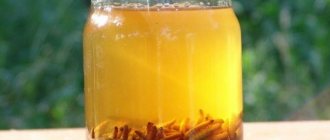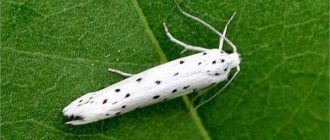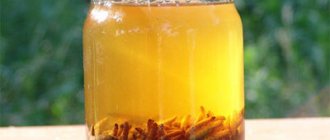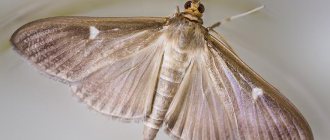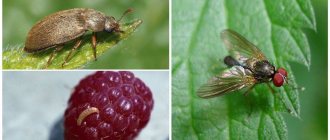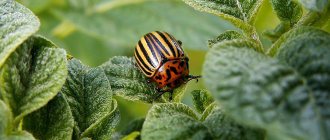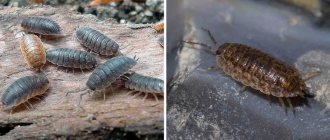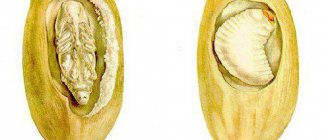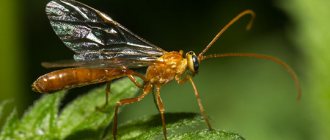Which beekeeper has not witnessed the damage that large and small wax moths cause to the industry? It has been established that the female large wax moth, entering the nest, lays 1500-2000 eggs on the surface of the honeycomb during 26 days of life, from which caterpillars emerge, move to the side wall of the cell, drill a hole in it and on the 4th day reach the middle of the honeycomb , in which exits are made on both sides. The caterpillar's passages are covered with cobweb-like yarn and become invulnerable to bees. An adult caterpillar climbs into a corner, into any crevice of the hive, spins a dense cocoon and turns into a pupa. After 14 days, the pupae enter the butterfly stage.
Bees of strong families drive butterflies out of the hive. For weak families, moths are a dangerous enemy, because each caterpillar consumes 0.4 g of wax for its full development, thereby damaging 500 or more cells. The development of bee colonies severely affected by moths is significantly delayed. Sometimes, due to severe destruction of the nest, bees leave the hive. The pest causes no less harm during storage of honeycombs.
In the apiary, moths are destroyed during routine inspections of bee colonies, and the bottom is periodically cleaned. Moths are removed from honeycombs removed from the hive by lightly tapping the frame. Severely affected honeycombs are removed, the nest is shortened, and it is well insulated, providing the bees with food reserves. When preparing honeycombs that have not been destroyed by moths for storage, they are disinfected.
The moth is destroyed at all stages of its development by keeping the honeycombs at a temperature of -10 °C for 1.5 hours.
Catching moth butterflies
To prevent butterflies from getting into hives or frame storage and laying eggs, it is easier to catch them. To do this, use liter jars filled with 3-4 cm of bread kvass, which are placed on the hives and in places where honeycombs and small frames are stored. The smell of bread kvass attracts butterflies. They fall onto its surface, their wings get wet and they can no longer get out of the jar. In addition to butterflies, no less harmful and annoying flies and midges get into jars.
During honey harvest, bees do not react to kvass and do not get into the jars. During the bee-free period, the jars are covered with plastic lids while the bees are flying. During the first day, from 30 to 70 butterflies end up in each jar. Subsequently, their number decreases. Catching butterflies with little time spent significantly reduces damage from wax moths.
Yu.I.Hupaviy
Wax moth: what is it?
When beekeepers think about wax moths, they mean 2 types of pests of honey bees: the bee moth (large wax moth) and the moth (small wax moth). Insects differ in body size and wing color, but they are united by similar biological development and the same “tastes”:
- Bee fire. The wingspan of butterflies reaches 35 mm. The coloration of adult individuals is dominated by brown, yellow and cream colors.
- Moth. The size of adult individuals does not exceed 24 mm. The wings are colored gray-brown and silver-white.
Bee fire.
Both types of parasites go through 3 stages of development. First, the female lays eggs measuring 0.5x0.35 mm, from which larvae emerge after 5-8 days. Actively feeding, they turn from microscopic (1 mm) worms into large (18-35 mm), well-fed caterpillars. This process takes about a month, then the future butterfly pupates, and after another 10 days a mature individual emerges from the cocoon, ready for mating.
The wax moth is fertile. During her short life, lasting only 7-12 days, the female is capable of laying up to 1.5-2 thousand eggs - up to 300 eggs. in every clutch. The natural death of moths occurs at the moment when their body runs out of nutrients accumulated during their stay in the larval stage.
Acetone against moths
In 4 hive bodies placed on the bottom of the hive, I place 40 dried frames. Many of them were attacked by moths. The upper body was covered and the hole in the ceiling was filled with plywood. I covered all the cracks, and then inserted a sheet of tin with a wall height of 10-12 mm the size of a notebook sheet through the tap hole. First, I put a clean cloth on the piece of paper and poured 100 g of acetone on it. The entrance gap was tightly closed with a plank and covered with plasticine.
On the second day, I removed the ceiling and examined some of the frames in the upper building. There were no longer any living caterpillars. Stopping further review, I covered the upper body again. Two weeks later I removed the ceiling and, when inspecting the frames, did not find a single living caterpillar. The dead caterpillars were black and mummified. This experience gives grounds to recommend acetone as an effective remedy in the fight against wax moths.
P. Batmanov
Cleaning and protecting honeycombs from wax moth larvae
How to get rid of moth larvae:
- Pour boiling water over infected and removed honeycombs from the hive and place in a dry and ventilated place until completely dry.
- If the affected area is not large, then the extracted honeycombs are placed in a container of water so that they are completely immersed in it. You should press something heavy on top so that they don’t float up. After a few days, the dead larvae will emerge.
- Wet combs are placed in a hive with a strong and active colony, and the individuals carry out cleaning on their own.
Honeycombs under the mesh
For the last two years, I have been storing spare honeycombs in a box with a fine metal mesh, through the cells of which moths cannot pass. Throughout the autumn-winter period, the box with honeycombs is constantly exposed to the air. I cover it with a roof to protect it from rain, and to prevent water from entering from below, I place it on a stand. Under these conditions, moths do not grow in honeycombs, and mold does not grow. There are several tiers of strips nailed to the inside walls of the box: one for nesting frames, the second for store frames. Honey, sealed in frames, despite the damp weather, is well stored and does not sour.
Ways to combat emerging moth larvae
When bee moth larvae are first discovered in an apiary farm, it is necessary to urgently take rescue measures, since the rapid spread of the pest will make further control more difficult and less successful. The silk web entangles the brood and it dies.
The bees try to free the young themselves, but they become entangled in the web and cannot fly. The difficulty of the fight lies in the fact that the presence of bees in the hive excludes many means of destroying the pest, for example, chemical ones.
We recommend reading tips for beginner beekeepers.
There remains only a physical method of control to kill the larvae, with the hope that the bees will go to the freed honeycombs:
- frames with caterpillars and signs of cobwebs are removed from the hive;
- pests are swept away from the frames;
- the frames are immersed in water for a day, then dried in the sun;
- It is advisable to add the cleaned frames to the hives of strong families that are able to independently fight the invasion.
If a moth nest is discovered, the bees will have to be relocated to another hive on new honeycombs with added food. Treat the hive itself (bottom, corners, tray) with a blowtorch or torch, trying to get into all the cracks.
Honeycombs, depending on the degree of damage:
- destroy if the degree of damage is great;
- heated at +50°C (for 2 hours);
- are frozen at sub-zero temperatures, which leads to the death of the larvae.
Moth is afraid of light
I noticed that the moth attacks mainly dark honeycombs, and if the honeycombs are light, then first of all, the places where the honeycombs collide with each other. The moth prefers dark places, avoiding light. We all know how difficult it is for a moth to part with a hive when the nest is opened. If she flies away from the hive, she immediately rushes to a darkened place.
It is enough to hold moth-infested honeycombs for 1-2 minutes in the sun, and all the larvae jump out. One autumn, for the first time, I hung honeycombs outdoors under a canopy, on the north side, at a height of 2.5 meters from the ground. I made L-shaped hooks from aluminum wire, with the help of which I hung the honeycombs under the canopy on the wire stretched there so that they did not touch each other. This way I store them when the cool nights come in the fall and continue to store them in the spring until warm nights set in. All cells are saved.
Methods of application
PZHVM extract infused with alcohol is a potent biological additive. It is advisable to use it after consultation with a specialist who will give recommendations for use.
According to average recommendations, it is necessary to use the tincture according to a certain scheme, which takes into account both the patient’s age and his illness:
- Adults on average should take 20-25 drops. The children's dosage is calculated based on the patient's age: one drop for each year of life after 6 years.
- It is recommended to use the product half an hour before meals. It is diluted with water in small proportions, no more than two tablespoons of water. The child can be given the extract by first mixing it with juice or tea.
- It is best to take the product 2-3 times a day, for prevention – 1 time.
- The duration of the therapeutic course is usually 6 months, but after 12 weeks you need to take a month's break and then continue treatment.
In order to cleanse the body of toxins
If the purpose of using the tincture is to cleanse the body of toxins, then it should be used according to a prophylactic prescription. That is, 20-25 drops once a day for three months, then take a month's break and continue taking the medicine for another three months. For greater results, it is recommended to combine the use of the product with everyday physical activity: a short jog, morning or evening warm-up is enough. Honey with PVH also demonstrates greater efficiency.
For adenoma
Dosage per dose – 5 drops for every 10 kg of patient weight. That is, we divide a person’s weight by 10 and multiply by 5. But no more than 35 drops at a time. Prevention: two to three times a day on an empty stomach, half an hour before meals, in courses of 2-3 months in spring and autumn. Treatment: three times a day, half an hour before meals, in courses of 3 months with a break between courses of 1-2 weeks.
For the treatment of myopia
Dosage for the treatment of myopia: 25-30 drops of extract 2 times a day (morning and evening). According to the standard scheme - 3 months, a month break, again 3 months. In this case, it is advisable to combine the use of the extract with special gymnastics for the eyes.
Fumigation with smoke
In the autumn-winter-spring period, when the nests of bee colonies need to be reduced, excess honeycombs have to be taken from the hives and stored separately in the hives or in special rooms. This is where the wax moth begins its harmful work. I smoked the honeycomb with sulfur. Moths did not breed in them, but the bees were reluctant to accept them. I left it in the hives behind the diaphragm for the winter - the honeycombs became moldy from the humidity. I put freshly picked lemon balm in the hives with honeycombs, sprinkled the honeycombs with dry mint, but the moths still started. I treated the honeycombs with vinegar - the moth died and did not start again. But this method has its own drawback, which cannot be ignored - acetic acid causes the wire in the honeycomb to rust and break. An old beekeeper once told me that in order to keep the honeycombs free from moths, he smoked them with ordinary smoke from a beekeeper's smoker. I immediately took advantage of his experience. In a container lined with tin so that mice would not penetrate into it, he hung several tiers of honeycombs at a distance of 12 mm from each other, like in a beehive, closed it tightly and filled it with smoke through a special hole at the bottom. I keep the chimney burning throughout the day. I repeat this fumigation three times at weekly intervals: in autumn and spring. If moths have already started in the honeycombs, then their caterpillars become inactive from the smoke, stop feeding, and die on the second or third day. The smell of smoke from the honeycombs subsequently disappears, and the bees readily perceive them. It is also interesting that moths no longer lay eggs in smoky honeycombs.
V. Nedbeev
It is enough to hold moth-infested honeycombs for 1-2 minutes in the sun, and all the larvae jump out. Last fall, for the first time, I hung honeycombs outdoors under a canopy, on the north side, at a height of 2.5 m from the ground. I made L-shaped hooks from aluminum wire, with the help of which I hung the honeycombs under a canopy on a wire stretched there so that they did not touch each other. I store them this way when cool nights set in in the fall and continue to store them in the spring until warm nights set in. All cells are saved.
Fumigation with smoke
During the autumn-winter-spring period, when the nests of bee colonies need to be reduced, excess honeycombs have to be removed from the hives and stored separately in the hives or in special rooms. This is where the wax moth begins its harmful work. I fumigated the honeycomb with sulfur. Moths did not breed in them, but bees were reluctant to colonize them.
I left it in the hives behind the diaphragm for the winter - the honeycombs became moldy from the dampness. I put freshly picked lemon balm in the hives with honeycombs, sprinkled the honeycombs with dry mint, but the moths still started. I treated the honeycombs with vinegar - the moth died and did not start again. But this method has its own drawback, which cannot be ignored - acetic acid causes the wire in the honeycomb to rust and break.
One day, an old collective farm beekeeper told me that he preserves honeycombs from moths by fumigating them with ordinary smoke from an apiary smoker. I immediately took advantage of his experience. In a container lined with tin so that mice do not penetrate into it, I hang several tiers of honeycombs at a distance of 12 mm from one another, like in a beehive, close it tightly and fill it with smoke through a special hole at the bottom. I keep the smoker burning throughout the day. I repeat this fumigation three times at weekly intervals - in autumn and spring. If moths have previously infested the honeycombs, their caterpillars become inactive from the smoke, stop feeding, and die on the second or third day. The smell of smoke from the honeycombs disappears over time, and the bees accept them willingly. It is also interesting that moths no longer lay eggs in smoky honeycombs.
B. Nedbaev, Maykop, Krasnodar region
Tart wormwood
In the first years of beekeeping, wax moths caused me great trouble, but over the past 20 years I have not lost a single comb, although I have hundreds of store-bought frames. After drying, I place the honeycombs in a box and line the frames on all sides with fresh wormwood. The box is not very tight - a knife blade fits through the cracks, but moths will never penetrate there.
F. Popov, Tchaikovsky, Perm region
Sandy immortelle
For many years now, I (and before that my grandfather) have been successfully using the herb of the sandy immortelle against wax moths. I harvest the plant during flowering and dry it in the shade. I put dry grass between the honeycombs. I store frames with honeycombs in various free drawers. The grass is fragrant, and moths avoid it.
N. 77. Vlasov, p. Chaadaevka, Inzensky district,
Ulyanovsk region
Vinegar helped
An accident helped me get rid of wax moths. There weren't enough dry frames, so I decided to wash the old brown honeycombs. I took a large tank, poured three buckets of warm water into it, added 0.5 liters of vinegar and soaked the honeycombs in this solution. Having processed the required number of frames in this way, I placed them in the hives and left the solution in the apiary. Imagine my surprise when I discovered many dead wax moths in the tank. The vinegar solution turned out to be a good bait for them. Now I have no problems with wax moths.
A. S. Solovyov, village Bruski, Egoryevsky district, Moscow region
Mol. drowned
The wax moth most often enters the hive in the evening or at night through the lower entrances, which are not guarded by bees at this time of day. One day I had the idea to leave a plate of honey-beebread mixture by the barn overnight. The next morning, I found 40 drowned large and small wax moths in it. The next day I repeated the same operation, but added a little yeast to the honey-beebread mixture. This time there were 73 butterflies in the plate.
Marmazov, Tomsk region
I store honeycombs in a bag
Honey collection largely depends on the preservation of honeycombs - the “golden fund” of the apiary. Over the course of five years, I tested different ways to store them. The next one turned out to be the most reliable. After pumping out the honey, I immediately place the honeycombs that will be stored in a prepared, clean case. The housings with honeycombs (I keep bees in multi-hull hives) are placed in prepared plastic bags and tied. I put the prepared packages into storage. I give the bees only those honeycombs that will be melted down for drying. With this storage method and control check after 1-2 weeks, there are no wax moth larvae. Honeycombs are perfectly stored for a long time and are always ready for use.
Pages: 2
see also
Disinfection of honeycombs Currently, many novice beekeepers are forced to initially buy ready-made honeycombs from other apiaries.
They cannot be used immediately, because most often they contain causative agents of many diseases... Folk medicine about honey If you want to preserve your youth, then be sure to eat honey. Ibn Sina (Avicenna) These famous words of the great physician, poet and natural scientist of antiquity are still relevant today. People have long believed that...
How to keep bees Only those who know well how a bee is born, what it does in the hive and in the field, how long it lives, how far it flies, how much it brings...
Vinegar helped
An accident helped me get rid of wax moths. There weren't enough dry frames, so I decided to wash the old brown honeycombs. I took a large tank, poured three buckets of warm water into it, added 0.5 liters of vinegar and soaked the honeycombs in this solution. Having treated the frames in this way, I placed them in the hives, and left the solution in the apiary. How surprised I was when I discovered many dead wax moths in the tank. The vinegar solution turned out to be a good bait for them. Now I have no problems with wax moths.
A.S. Solovyov
About the pest
Wax moth, more often called moth, is a very dangerous pest. For many years it was considered the main pest, because its larvae eat honeycombs with unprecedented appetite. The adult lays eggs in the hive, and the offspring themselves form a dense white thread, moving along the frames. It was these threads that led to the death of young individuals, since they were unable to untangle themselves from them.
Recently, more and more observations and experiments have been carried out that prove that the adult prefers old honeycombs for laying eggs. She lives a little less than a month, but is very prolific; during this period she manages to lay up to 2 thousand eggs. The larva also develops within a month, eating very little wax. But it is worth considering the number of individuals: all together they eat up to 1 kg of wax.
This means that one wax moth offspring destroys up to six honeycomb frames, which is very disadvantageous for the beekeeper. Do not forget that there can be many moths ready to lay eggs in honeycombs, and the consequences can be very sad.
Polyethylene will protect against moths
Honey collection largely depends on the preservation of honeycombs - the “golden fund” of the apiary. Over the course of 5 years I have tested different ways to store them. The following method turned out to be reliable. After pumping out the honey, I immediately place the honeycombs that will be stored in a prepared, clean case. The housings with honeycombs (I keep bees in multi-hull hives) are placed in prepared plastic bags and tied. I take the prepared packages into storage. With this storage method and control check after 1-2 weeks, there are no wax moth larvae. Honeycombs are perfectly preserved for a long time and are always ready for use.
Before installing them in the hive, I lightly sprinkle them with warm water and give them to the bees mixed with wax. I expand the nest with the whole body at once. I also install store extensions. The bees master the honeycomb and quickly remove the foundation.
V.A.Eskiy
Preventive measures
The problem is easier to prevent, so everyone who has connected their life with bees should take preventive measures to keep losses to a minimum. These methods include:
- Keeping the hives and apiary area in perfect order.
- Eliminate all deficiencies in a timely manner and devote as much time to repairs as required.
All the gaps and crevices in the hive can become potential nesting sites.
For the purpose of prevention, plants are planted in and around the apiary, the smell of which repels moths. These include:
- mint and lemon balm;
- pelargonium;
- sagebrush;
- marigold.
Baits: honey and vinegar
To prevent the butterfly from getting into the hive, beekeepers place bowls with a mixture of beebread and honey next to it. This should be done in the evening, when the bees no longer fly. The moth is nocturnal and in the morning it will be possible to collect butterflies drowned in honey. Yeast is added to moth bait; it has been noted that the effectiveness of such a mixture is higher.
The butterfly is also attracted by the smell of vinegar. It must be diluted in water and the container must also be placed next to the hive.
Water hazard
To prevent larvae from crawling from an infected hive into a clean one, some beekeepers create a water barrier: they dig around the perimeter of the hive in which the larvae have hatched, make a groove and fill it with water.
Honeycombs must be systematically checked for the presence of pests. If it is detected, measures are taken immediately. Bees must freely penetrate into any corner of the hive, so they can fight off uninvited guests.
The worker bee itself is able to neutralize the pest; it simply eats it. When a pupa is found, it seals it with propolis and the pupa dies. The guard bees are responsible for penetrating the enemy's hive; they certainly know how to get rid of the presence of wax moths on the frames - they simply do not allow the larva into the hive.
The presence of wax in the apiary attracts the moth, so you should avoid storing supplies in the same place where the bees live. To prevent the larvae from moving from one dry enclosure to another when storing them in a column, you need to lay film or oilcloth on the lid of each, or even better - newspaper (moths cannot stand the smell of printing ink).
Traditional methods
To fight moths, I use proven folk remedies - mint, oregano, wormwood, walnut leaves. At the bottom of the box in which the dry food is stored, lay a layer of fresh green stems of these plants, install the frames tightly, and also place the stems on top of them. For 5 years there were no moths in the boxes, although some boxes were not opened for two years. By the way, oregano or mint, placed around beehives or under honey frames in boxes, reliably repel ants.
S. Kuzminsky
Fighting moths in the hive
Physical methods
Simultaneously with chemical effects, physical ones are used.
Most often, the frames are heated at a temperature of 50 degrees Celsius for an hour. You can lower the temperature to 40 degrees, but the warm-up time will take three hours. If the degree of infection is high, the honeycombs are doused with boiling water and then left in a draft or in a cool place. This stress treatment is highly effective. This temperature is detrimental to parasites, but the beebread will be unsuitable for subsequent use.
Chemical methods
There is a special anti-moth product on sale in the form of “StopMol” plates. But gardeners have a low opinion of it, since its use cannot protect the hive from the appearance of parasites.
The most effective remedy used by beekeepers is thymol. It is laid out in bags and placed in a box where the frames affected by caterpillars are located.
ATTENTION: When the temperature in the storage reaches 25 degrees, the poison must be removed
Walnut leaves
For many years I have been storing wax moth dry as follows. In August-September, I collect walnut leaves from the tree, dry them well, and when I start putting the honeycombs in a chest for winter storage, I sprinkle them with these leaves. I also use hops. When it is ripe, I collect it in the forest, dry it and pour it into frames. The honeycombs were never damaged. Many local beekeepers took my advice and always thanked me.
I.M.Makogin
Fighting methods
First of all, the preventive measures described above help against wax moths and their larvae. But the fight against such a scourge requires much more time and effort, and if measures are not taken in a timely manner, the production of food honey in the apiary can be greatly affected. You should not completely rely on the destruction of the parasite by the bee colony.
You should ensure that the size of the bees' nest is correct. After all, its excessive expansion will not only become a more attractive place for various pests, but it will also be more difficult to control and maintain. To do this, you should prepare a special room in which the honeycombs will be stored.
In the case of a large amount of sushi, it has to be treated with a special OKEBM mixture, which is a mixture of gases. The product is supplied at a rate of fifty grams per cubic meter in sealed chambers, at a temperature of 15 degrees Celsius, but not less than ten hours. Naturally, you won’t be able to withstand such fumes on your own, so you have to work in a gas mask.
Other gases can also be used as measures to prevent the occurrence of unnecessary living creatures in the honeycombs. However, it is worth noting that such methods will not necessarily help get rid of the actual presence of wax salt or its larvae. In this case, it is better to take other measures and means.
Remedies for moths and larvae
If preventive measures to protect against wax moths did not perform well, then, most likely, they were simply poorly carried out in the apiary. Therefore, you have to get rid of insects by direct action.
One of the simplest measures to combat wax moths is to keep the honeycombs for an hour at a temperature of fifty degrees Celsius. A slightly more complicated option is to lower the temperature to ten degrees, but with the expectation of a three-hour procedure.
However, beebread honeycombs will not withstand this option. This temperature regime will definitely kill the pest, without harming the honey itself, allowing it to continue to be used as a medicinal product.
As for the hives themselves, it is advisable to warm them up with a blowtorch. But only iron and wooden elements, since it is quite logical that paper and straw elements will not survive this. This can be done before moving the bee family into the hive and before wintering.
Some beekeepers take such measures even in the summer, but it is worth trying to ensure that the bees themselves are not in this structure.
In order to destroy pests, you can also use chemicals. To do this, use formic or acetic acid on damaged honeycomb elements. To do this, they are removed to a previously prepared place. Under no circumstances should this event be carried out in the hives themselves.
You can also get rid of parasites using sulfur gas. No one claims that it is simple and safe, but it definitely allows you to fight the scourge. This product allows you to get rid of the caterpillars themselves, which eat wax treated with this substance.
You can also turn to folk remedies, which are easier and more enjoyable to use.
Folk remedies
Since our ancestors knew how to get rid of wax moths in beehives, using their methods will at least be accessible and reliable. After all, folk methods for eliminating infection have a centuries-old, proven history.
The fight against parasites itself is carried out by simply repelling the smell of the leaves of some trees. The most powerful effects are from nuts, peppermint, mint, oregano, hops and wormwood. You can also use orange peels, elderberries, and garlic.
Since the pungent odors of moths are unbearable, such methods against pests will undoubtedly be very useful in the apiary, especially considering that you do not need to use any gases for this.
You can find out how to most simply and effectively fight against the hated enemy of hives - wax moths - from the following video. Storage of materials and means for this, as well as application standards are also considered. In addition, from such materials you can always glean some new grain of knowledge about beekeeping. You can learn more about the problem from the video.
Peppermint
Knowing that mint tincture is sprinkled on bees during the union of families, it is harmless to bees, but wax moths are afraid of it, I added 30 drops of mint tincture to 50 g of water, lifted the floorboards on both sides of the nest and gradually poured the solution between the frames. I did this in the evening, when the bees stopped flying. On the 2nd day I examined the bees - they behaved calmly, all the larvae fell off, the bees worked together. A week later, the larvae appeared again - I re-treated the bees, and the result was also positive.
Garlic against moths
Garlic is a good repellent and disinfectant. It is placed in flour and wheat against flour mites. Since ancient times, people have used garlic to disinfect the intestines, etc. This gave me the idea to use garlic against moths. In the fall, when sorting honeycombs before collecting them for long-term storage, I carefully clean the bars and frame strips of propolis and wax and lightly rub them with garlic. The bodies and free hives that I use to store honeycombs are also cleaned from the inside and rubbed with garlic.
In the spring, with the onset of warmth, I put a little finely chopped garlic in the frame storage on the racks and in the housing with honeycombs. I also place one clove of garlic, cut into three parts, on the insulation sheet in each hive. The results are excellent every time: there are no moths in the apiary, the bees are always healthy, the colonies grow well and are always highly productive. Costs are low. For 100 bee colonies, 30 heads of garlic are spent per season.
Facilities
The market offers a wide range of products, various chemicals against larvae: folk remedies, acetic and formic acid, special preparations and much more.
Folk
The method of fighting with folk remedies, as a rule, is less effective compared to chemical preparations for moths in the field of beekeeping. However, they are widely available and harmless to honey bees.
Plants widely used: mint, hops, garlic, wormwood, thyme, black root, lemon balm. The integrated use of a set of plants enhances the effect. They can be placed near the hives, placed on top of frames or next to the hay storage. The insect also does not tolerate the smell of printing ink, so it is recommended to add fresh newspapers or magazines.
Sometimes you can make a saline solution, which is used less often in practice. The honeycombs freed from honey should be dried and treated with a solution. After drying, the formed sediment should be removed. Before installing honeycombs into hives, you should rinse them with water.
Also used are peculiar traps in the form of honey water with the addition of yeast. An adult individual falls into the water and dies, which reduces the likelihood of infection of the apiary.
Formic acid
Formic acid vapor instantly kills eggs and larvae. The larva, due to the fact that it is in a cocoon, is more stable, so longer exposure to vapor is required. For the same reason, bee honeycombs are treated immediately after removal from the colony to prevent the release of larvae.
For treatment, you need to spray the hive with 14 ml of formic acid, then cover it for 3-5 days immediately and after another 10 days.
Sulphur dioxide
The use of sulfur dioxide is an effective way to combat larvae. It is a highly volatile, fat-insoluble gas and therefore poses no significant risk to bees, wax or honey. It is heavier than air, so it easily settles in the frames being processed.
This control method should begin by placing the affected frames in a separate box. Place a source of sulfur gas under the frames. These may be special strips that need to be held over the burner. After this, close the box. The procedure is recommended every 4 weeks. It also helps eliminate mold from the hive.
Before fighting wax moth larvae in hives, you need to familiarize yourself with safety measures, because sulfur dioxide is poisonous to humans.
Vinegar
80% acetic acid, which can be used regularly as a pest control agent, will control the larvae population to a certain extent. However, there is uncertainty regarding the susceptibility of eggs and pupae. Effective control of it depends on the concentration of acetic acid, the volume used, the effectiveness of sealing the hive, and the period of time during which the honeycombs are exposed to the vapor.
The required 80% acetic acid is a dangerous and aggressive corrosive substance that poses a hazard during storage and use. It is also important to remember that the metal components of the hive can be subject to corrosion, so prolonged exposure to vinegar is not recommended.
To treat affected honeycomb frames, place them in an empty hive. Place a container with 200 ml of 70-80% vinegar solution under the frames. The procedure lasts for 3 days, after 10 days it must be repeated. Before installing the frames, it is necessary to ventilate them. It is more effective to combat it in a cell storage facility. Before you start fighting moths in your apiary, it is recommended that you familiarize yourself with safety precautions.
Askomolin
Ascomolin is a drug that allows you to destroy the insect without significant harm to the health of the bees. The affected honeycombs are placed in the hive, 10 tablets are placed on each frame. The use of ascomolin as a way to combat moths in the hive is recommended by beekeepers.
Antimol
Another insect repellent in beekeeping is anti-moth, which is a universal remedy for repelling adult insects. On the inside of the hive, it is necessary to place a product that emits an unpleasant odor that repels imagoes.
Biosafe
Biosafe is a biological preparation containing Bacillus thuringiensis, a bacteria dangerous to the larvae. For processing, prepare a suspension and spray 25 ml per frame, so for 10 frames you need to prepare 250 ml, for 50 frames - 1250 ml.
Bacillus treatment, as a way to remove moths from a hive, is an excellent example of exterminating pests without affecting the bees.
